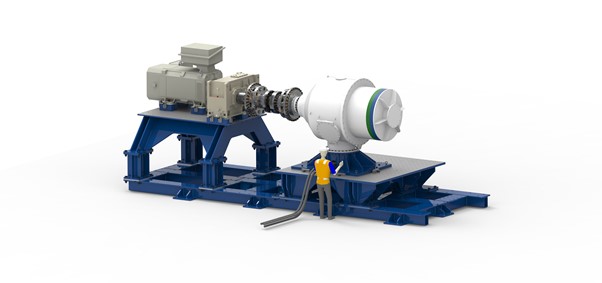John Walker, Project Engineer, Offshore Renewable Energy (ORE) Catapult
What is ELEMENT?
The ELEMENT control system is being developed under a €5 million project funded by the European Union’s Horizon 2020 research and innovation programme. It will show how artificial intelligence can slash the cost of tidal energy by an estimated 17 percent, bolstering the case for tidal energy as an important part of the world’s future energy mix. From mid-2019 to mid-2022, eleven academic and commercial partners are working together to develop and demonstrate the ELEMENT control system for Nova Innovation’s turbines.
Onshore turbine testing
Preparations are now well underway at the ORE Catapult testing facility in Blyth for ELEMENT’s onshore testing programme. The onshore testing will see the Nova RE50 tidal turbine installed on ORE Catapult’s 1 MW powertrain test facility and is the first in a series of test campaigns to verify the ELEMENT control system performance. On successful completion of the onshore testing the turbine will undergo tow testing before being transported to the Étel estuary test site in Brittany. The optimised and validated ELEMENT control system will then be installed on an existing Nova M100 tidal turbine in the Shetland Tidal Array.

The key mechanical components of the test rig are shown above and include: the prime mover (motor and gearbox assembly), on the left; the Nova RE50, on the right; a flexible coupling connecting the gearbox output to the RE50; and the support frame. Communications between the test rig and RE50 are handled by Modbus and PROFINET protocols for the control and National Instruments data acquisition systems, respectively.
You may be wondering why the turbine is missing its rotor blades. As can be imagined, testing onshore with the 4.5 m blades rotating at speed would present numerous complex challenges. However, the rig control system can be modified to simulate the effects of the missing blades with a technique called hardware-in-the-loop (HIL).
What is hardware-in-the-loop?
Hardware-in-the-loop is a simulation which replaces an element of the simulation with hardware. In this case, it combines the assembled test rig hardware and instrumentation with a software-based simulation of the turbine rotor to provide a realistic real-time representation of how the turbine would behave in a typical tidal flow.
Tidal turbines experience highly turbulent flows. Add in shear, tower shadow and wave loading effects and you have a complex flow field. This in turn varies the loading distribution across the blades, hence the rotor shaft torque and speed also vary. For ELEMENT, a mathematical model has been developed which accounts for the variations in the flow and system dynamics to determine what the rotor torque should be at that point in time.
The calculated value is used in the hardware-in-the-loop control in place of the rotor torque contribution – the torque provided by the prime mover to the turbine shaft replicates that provided by the turbine rotor. This allows the ELEMENT control system to experience real-world conditions that can be variable with the added control and repeatability of laboratory testing.
What will the onshore testing achieve?
The test set up allows the performance of the ELEMENT control system to be demonstrated for representative tidal flow conditions. The onshore testing provides a controlled test environment where test conditions are defined by the operator – not the prevalent tidal or sea conditions.
Not only does this provide a unique opportunity for tuning and optimisation of the control system under controlled conditions, but also improves confidence of the ELEMENT control system performance by minimising the risk of early complications and unplanned maintenance – significantly easier to address in the test hall compared to an offshore deployment.
The data gathered will verify the ELEMENT control system performance, across a range of tidal conditions, and provide the opportunity to complete initial optimisation of the control system prior to the offshore testing programme – key elements of successfully delivering the ELEMENT project.
Ultimately, the onshore testing provides independently verified results that will help developers across the sector assess the benefits of introducing intelligent control systems to maximise energy capture and reduce operational overheads.


